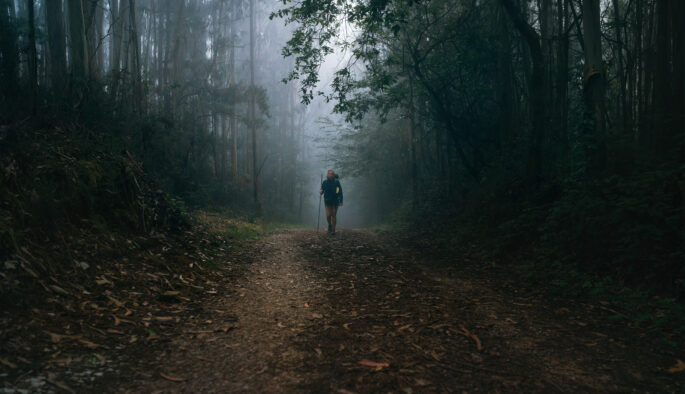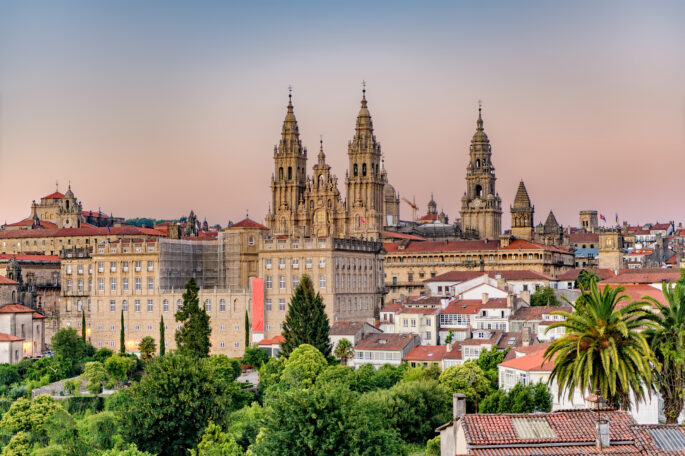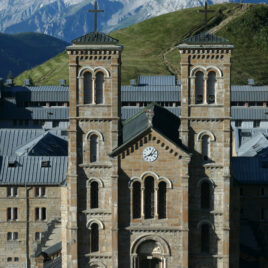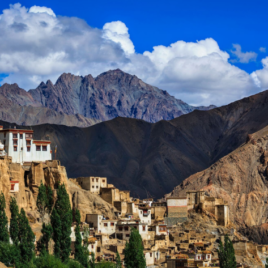
In an increasingly fast-paced and hyper-production-driven world, many yearn to return to something timeless, slow-paced, connected, and meaningful. For some, this call manifests in a desire for pilgrimage—a spiritual journey that challenges not only the body but also the mind and soul. As I prepare for my upcoming pilgrimage on Japan’s ancient Kumano Kodo trail this month, I’m also looking ahead to its sister pilgrimage, the Camino de Santiago in Spain, which I will lead in June 2025, hosted by Sacred Earth Journeys. These two ancient routes—spanning continents, cultures, and centuries—offer more than just beautiful landscapes and cultural immersion; they present an opportunity to reconnect with deeper, often forgotten, butessential, parts of ourselves. More than this, these pilgrimage trails are initiatory training grounds, preparing us for a new, rapidly emerging future.
In this month’s blog reflection, we’ll explore the rich history of both the Kumano Kodo and the Camino de Santiago trails, delve into the fascinating connection between these two sacred pilgrimages, and discuss the profound psychological, physical, and spiritual benefits that pilgrimage offers. We’ll also touch on how the changing attitudes toward travel—from leisure to purpose—presently emerging from the collective unconscious represents a broader paradigm shift that will dramatically change how we see the world and our role in it.
Whether or not you feel drawn to embark on such an outward journey yourself, pilgrimage as a broader archetype holds timeless lessons for navigating the sea change of our modern life, offering a meaningful counterpoint to how we have been conditioned by the digital age and, more broadly, the materialistic paradigm that is now sunsetting.
The History of the Kumano Kodo and Camino de Santiago
Kumano Kodo: Japan’s Sacred Network
The Kumano Kodo pilgrimage trails, located on Japan’s pristine Kii Peninsula, have been traveled for over a thousand years by everyone from emperors to peasants to ascetic monks seeking spiritual renewal. The Kumano region is often referred to as the “land of the gods” due to its association with Shinto nature spirits and Buddhist teachings on impermanence, no-self, and liberation; it is a territory considered among Japan’s most sacred ground. Unlike many modern pilgrimages, which often have a single destination, the Kumano Kodo is a network of interconnected routes, each leading to the Kumano Sanzan—three ancient shrines revered in both Shintoism and Shingon or esoteric Japanese Buddhism. These three shires, Hongu, Nachi, and Hatayama beckon the pilgrim to reflect in three corresponding stages on one’s past, present, and future as they walk towards each landmark. By the tour’s completion, the pilgrim has consolidated and processed their past, emptied and made themselves fully available to the present, and begun to seed and incubate a vision for themselves and the world for the future. A process in line with the alchemical motto, solve et coagula, to dissolve and reconstitute, which I’ll soon return to. On our pilgrimage next month, we have elected to venture off the beaten path and directly into the secret heart of Kumano to its most enchanted, spirit-inhabited, and energetic enclaves. Our pilgrimage has a novel agenda: to pair our Tibetan Vajrayana master Geshe Tenzin Zopa featured in the Unmistake Child documentary in a historic dialogue with a local trickster and shaman named Kosho Tateishi featured in the Shegendo Now documentary. The aim is to meld minds and traditions in an archetypal symbol of mandalic unity and diversity, just as we did in Indonesia last year, blending Buddhist and Shiva streams of tantra.
What makes the Kumano Kodo particularly unique is its blending of spirituality and nature. Just like my experience with Balinese tantra, the local Shugendo religion fuses Shinto animism, shamanism, and Shinto tantric Buddhism, taking pilgrims through enchanted forests, across rivers, and over mountains, encouraging a deep connection to the land and local spirits as part of the spiritual journey. Pilgrims often walk in silence, voluntarily endure intense weather and physical challenges, and even bathe under frigid waterfalls—not only out of respect for the sacred practices of Shugendo but also to overcome worldly desires, the tyranny of preferences, and the constant chatter of ego, so they can create stillness through discipline to better hear the voice of their inner soul. As I write in my forthcoming book Return with Elixir, this scared destination of finding home—the soul—is what pilgrimage shares in common with psychedelics. Both represent inner journeys of awakening. While the latter is radical and direct but not for everyone, the former is more gradual, less reality-obliterating, but perhaps more accessible.
Camino de Santiago: Spain’s Timeless Route

On the other side of the world lies the Camino de Santiago, another pilgrimage that dates back over a millennium. The Camino culminates at the Cathedral of Santiago de Compostela in Spain, where the remains of the virtuous St. James the Apostle are said to rest. It became a major Christian pilgrimage route in medieval Europe, drawing the devout from France, Spain, and Portugal on trails that can extend beyond 600 miles, with some dating back to the 9th century. While many still walk the Camino for religious reasons, its appeal today extends far beyond any particular faith tradition.
One of the most powerful aspects of the Camino is how it serves as a metaphor for life itself, with its twists and turns, ups and downs, unexpected bumps, and profound breakthroughs; the journey reflects the everyday tragedies and triumphs we encounter in daily life. The reason I’ve elected the Camino ‘Walk of Renewal’ to coincide with the launch of Return with Elixir is that my book reveals the universal key—solve et coagula—that opens every esoteric gate the world over, and, in so doing, provides us direct access to engage with any spiritual tradition or wisdom culture through the collective language of archetypes and universal motifs.
Chief among these motifs is the mystical reference solve et coagula, ‘dying to be reborn’, allowing one’s ordinary identity to dissolve, to be spiritually renewed. With this universal motto as our path, we have a compelling rationale for doing Tibetan-style visualizations and Buddhist prayers in churches along the Camino, perhaps the most celebrated, well-traveled Christian pilgrimage route in the world, because we can cut straight through to its universal heart, embodying agape (love) and apotheosis (becoming divine), rather than get stuck at its superficial distinctions, and idiosyncratic dogmas. For this reason, we could similarly one day venture to the King’s Chamber in the Great Pyramid on the Giza plateau to chant Tibetan mantras, discuss the Tibetan Book of the Dead, and participate in rebirth visualizations enhanced by intensive yogic breathwork and sound bath, with there being no contradiction, because the mystical traditions of all cultures have similarly pursued a radical alteration in consciousness, dramatically aimed at immortality.
Walking the Camino is physically demanding, but it’s not the physical difficulty that brings people back again and again—it’s the profound transformation that takes place within the human heart when the thick crust of self-protection and dissociation is broken through to the common, supple ground of vulnerability beneath. Pilgrims often speak of the Camino as a place where their hearts and minds become aligned through trial, where the noise of modern life fades away, and a clearer sense of purpose emerges from hardship, compelling them to make a radical shift in their lives upon returning home or offering their unique gift to the world.

The Pilgrimage Mindset
Pilgrimage is not always straightforward, pleasant, predictable, or even enjoyable. How would it be beneficial or distinctive if it were? The difference between tourism for pleasure’s sake and pilgrimage for growth is a state of mind. Recently, one of my friends, a seasoned pilgrim, went to Tibet to circle the sacred Mount Kailash. The night before the large group of fifty embarked from Chengdu, China, their jumping-off point to Tibet’s Autonomous Region, not one but both tour leaders had their permits unexpectedly pulled and were not allowed to accompany the group. These tour leaders were among the main draws for the journey; without them, what kind of tour would this be? Many people were understandably frustrated and disheartened, but some got “stuck” in an eddy of mind-created suffering, fixated on the unanticipated loss and change in plan from what was expected.
My friend, however, was able to pivot rather quickly into the “pilgrimage mindset,” seizing the challenge as an opportunity to work with whatever misfortune arose as a means to awaken her mind. She noted to me after the tour, having reached and circumambulated holy Kailash, that she was proud of herself—not just for enduring the immense physical difficulties, but mostly because she had found her mind to be a reliable source of stability, true refuge, while so many others on the trip succumbed to the whirlpools of anger and disappointment. In essence, my friend had become the sacred destination herself, not a physical place to arrive at but a set of inner qualities to cultivate and embody along the way. She didn’t pay her money to be a passenger, observer, or visitor, spoon-fed throughout the ride by her more accomplished teachers; she was an active participant, guiding and refining herself like pottery along the spin of the journey. As I’ve said before, “The pilgrimage is empty, like life, you experience what you make of it.”
The Connection Between the Two Pilgrimages
While the Kumano Kodo and Camino de Santiago exist in vastly different cultural and religious contexts, they are recognized as “sister pilgrimages” through their shared UNESCO World Heritage designation. But the connection goes deeper than just an official title. Both pilgrimages lead to sacred sites, yet, as we see from my friend’s living testament at Kailash, it’s our approach to the journey that transforms us and not the destination. Both routes demand something from the pilgrim—whether that’s endurance, vulnerability, or simply the willingness to come undone, to be recast anew. As I write in Return with Elixir, we must possess a willingness to lose control and, ultimately, to lose ourselves so that we can find a deeper, more robust self we never knew existed. In both cases, Japan and Spain, the pilgrim is not just a tourist or traveler but a co-author, artist, or alchemist, active in the creative work of self-redesign in a multidimensional journey that unfolds both inwardly and outwardly.

The crux of Return with Elixir is that we are all pilgrims looking for our long-lost soul. Unlike King Odysseus yearning for his beloved home and family on Ithaka Island after a ten-year absence and odyssey, we are equally lost in the wasteland of modernity, filled with angst, yet unaware of what we’re missing. We’ve been filling the abyss of the heart with material possessions and transient experiences that don’t last or satisfy our deeper yearning, but our modern culture has failed to orient us to the possibility that there are other worlds beyond the five senses and innate qualities of mind, buried like treasure, that when cultivated, can offer lasting satisfaction. We need a map, compass, and guide to reacquaint ourselves with the inner landscape and the ultimate, sacred destination within.
As we walk outwardly through bucolic landscapes, we are following the paths along what I call the inner ‘soulscape,’ best articulated by mythologist Joseph Campbell, from departing the ordinary world through sacred initiation, facing an ordeal, uncovering a buried treasure, and returning home to benefit others. Mystic Carl Jung traced a similar circumambulation, departing ordinary consciousness and calcified ego, venturing into the netherworlds of the shadow to confront our greatest fears, piercing the veils of the collective unconscious where we can reclaim the soul, a sense of wholeness, then coming back into a more adaptable ego to live authentically in the world. These two systems, combined with the cycle of the Tibetan process of conscious death, sublime liminality, and altruistic resurrection and the cosmological precession of the so-called Great Year, lasting 24,000 years, are the four maps compiled in Return with Elixir’s 440 pages, a field guide for rebirth.
The Dual Personalities of Kumano and Comino
The concept of “dual pilgrimage” encourages people who have completed one route to walk the other. If you join me in Japan this year, perhaps you will also come to Spain next year, if you join us in Spain in 2025, perhaps, if there’s enough interest, we’ll run Japan again at a future date and alternate back and forth over the years. You’ll get a taste of the unique vibe of each tour as you forge deeper along your singular grail quest. As I reflect on this, I’m struck by how these pilgrimages serve as unique counterpoints to each other. In Japan, the focus is often on nature, subtlety, solitude, and quiet introspection. In Spain, it’s the vibrancy, sensuality, community, and shared experience of transforming hardship and loss. Yet, both paths offer opportunities for self-discovery and transformation, reminding us that the path to awakening takes many forms and even many lifetimes, so one can venture on different kinds of pilgrimages, again and again.
You can read part two of this blog post series here.
Written and published by Dr Miles Neale originally here.
Dr Miles Neale is a psychotherapist, teacher of Tibetan Buddhism, and pilgrimage guide with twenty-five years of experience integrating science and spirituality. Founder of the Gradual Path for inner and outer journeys, Miles is the author of Return with Elxiir, Gradual Awakening, co-editor of Advances in Contemplative Psychotherapy, and lives in Bali, Indonesia. He is the tour leader on our journey: Walk of Renewal: Camino de Santiago with Dr. Miles Neale taking place in June 2025.

